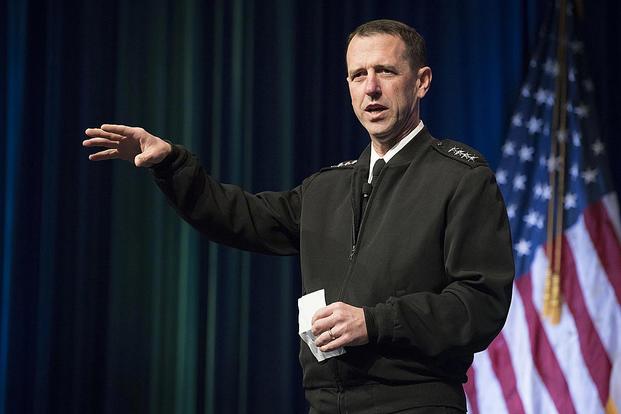The Navy's top admiral is calling on the service's most junior leaders to be proactive and troubleshoot subpar working conditions after two collisions involving Navy destroyers this summer left 17 sailors dead.
Just hours after the destroyer John S. McCain collided with a tanker outside Singapore on Aug. 21, Adm. John. Richardson publicly announced that all commands across the Navy would observe an operational pause to ensure units were operating safely and effectively.
The McCain collision, which left 10 dead, came just two months after the destroyer Fitzgerald collided with a container ship southwest of Tokyo, killing seven sailors.
In a memo to the fleet published Friday, Richardson said feedback from the operational pause is still rolling in, but one clear insight has emerged: Unit leaders need to take greater ownership of their commands and ensure sailors are operating under safe and sustainable conditions. The memo was first reported on by USNI news.
Related content:
- Military Mishaps Have Claimed as Many Lives as Vegas Attack: Lawmaker
- Why Are Navy Ships Colliding in the Pacific? Experts Weigh In
- Investigation Faults Navy in Fitzgerald Collision: Report
"While there is more to follow soon on those important matters, it is clear NOW that a center of gravity for our IMMEDIATE efforts going forward must be to enhance the role of small teams and their leaders," Richardson wrote in the emphatic memo.
"When I hear about problems like persistent lack of sleep, consistently long work hours in port, problems in basic watchstanding, and more, it's clear to me that much of the fix is with our junior leaders," he wrote.
The Navy is guilty, Richardson continued, of stealing leadership opportunities from small team leaders in the pressures of leading a large organization.
"We've used a slide show instead of leadership by personal engagement," he wrote. "We have robbed our junior leaders of the ownership they so crave. We have smothered their initiative. We need to give it back -- it's why they joined the Navy."
Richardson indicated that, through the operational pause, the Navy had found this area of small unit leadership constitutes the largest area for improvement within the service.
"By virtue of piling on meaningless collateral duties and programs that contribute little to operational and warfighting excellence, we have confused these leaders, making it hard for them to see through the chaff and to prioritize the personal and professional development of their people," he wrote. "An astute and well-trained division officer and chief will ensure that their teams are trained, certified, well rested, respectful, and ready to go."
In the wake of the collisions, the Navy's most immediate action, in addition to the operational pause and two wide-ranging operational reviews, has been to fire its most senior leadership with authority over the units involved.
Just 24 hours after the McCain collision, U.S. Pacific Fleet Commander Adm. Scott Swift relieved Vice Adm. Joseph Aucoin, commander of U.S. 7th Fleet, where both deadly incidents took place.
Aucoin's replacement, Vice Adm. Phillip Sawyer, moved quickly to remove two more leaders: Rear Adm. Charles Williams, commander of Task Force 70, and Capt. Jeffrey Bennett, commander of Destroyer Squadron 15, to which both destroyers involved in the collisions belonged.
Swift has also announced his plans to retire after being passed over for nomination to lead U.S. Pacific Command.
In hearings before the House and Senate Armed Services Committees following the incidents, lawmakers have cited reports from the Government Accountability Office showing troubling readiness problems affecting ships deployed to the Pacific, including slews of lapsed certifications, operations schedules that left no time for formal training, and practices that left sailors sometimes working 100 hours per week.
"I personally made the assumption, and I have made the assumption for many, many years that our forward-deployed Naval force in Japan was the most proficient, well-trained, most experienced force we had, because they're operating all the time," Vice Chief of Naval Operations Adm. Bill Moran told members of the House Armed Services Committee on Sept. 7.
"It was a wrong assumption, in hindsight," he said.
The Navy is already moving to remedy some of the most pressing issues.
Vice Adm. Tom Rowden, head of Naval Surface Forces, published a memo in late September ordering ship captains to ensure sailors have adequate sleep and predictable watch schedules, to guard against operational mistakes due to sleep deprivation.
Navy commanders are also reportedly encouraging sailors to avoid over-reliance on technology, instead using simple tools such as pencils and paper to track obstacles in busy shipping lanes.
In his memo, Richardson encouraged commanders to prioritize developing junior leaders and teams.
"No commander can do very wrong if you are training and empowering your junior leaders," he wrote. "Through example, teaching, and engagement, we must produce leaders and teams who learn and adapt to achieve maximum possible performance for prompt and sustained combat incident to operations at sea. It's the only right thing to do."
-- Hope Hodge Seck can be reached at hope.seck@military.com. Follow her on Twitter a @HopeSeck.





























